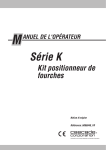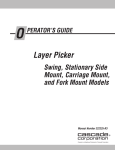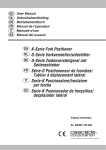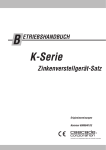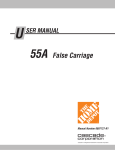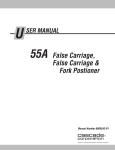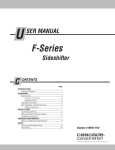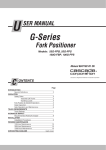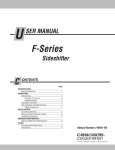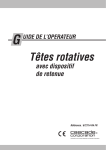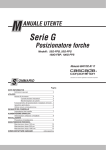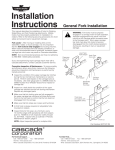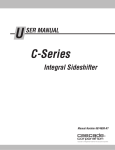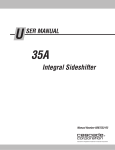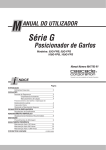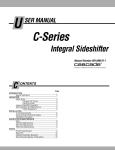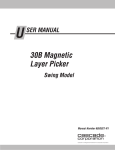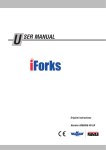Download 6054167R6 K-FPK User Manual
Transcript
U
SER MANUAL
K-Series
Fork Positioner Kit
Manual Number 6054167-R6
cascade
corporation
Cascade is a Registered Trademark of Cascade Corporation
C
ONTENTS
Page
INTRODUCTION
Special Definitions
OPERATION
Safety Rules
Industrial Lift Trucks
Handling Loads
Fork Positioner Operation
Daily Inspection
Safe Operation and Maintenance
OSHA Regulations
INSTALLATION
Truck Requirements
Recommended Hydraulic Supply
Installation Procedure
PERIODIC MAINTENANCE
100-Hour Maintenance
300-Hour Maintenance
1000-Hour Maintenance
2000-Hour Maintenance
PARTS
Product Identification
Recommended Spare Parts
Publications
i
1
2
2
3
3
4
5
5
6
7
8
14
14
14
15
16
16
16
6054167-R6
I
NTRODUCTION
This User Manual is for the Cascade K-Series Fork
Positioner. Contents include an Operator's Guide,
Installation Instructions, Periodic Maintenance and
Recommended Spare Parts.
NOTE: All specifications are shown in US and (Metric) units
where applicable. All fasteners have a torque value range
of ±10% of stated value.
IMPORTANT: K-Series Fork Positioner is metric. Supply
fittings adapted as required for application.
Special Definitions
The statements shown appear throughout this Manual
where special emphasis is required. Read all WARNINGS
and CAUTIONS before proceeding with any work.
Statements labeled IMPORTANT and NOTE are provided
as additional information of special significance or to make
the job easier.
WARNING: Rated capacity of the truck/
attachment combination is a responsibility
of the original truck manufacturer and may
be less than shown on the attachment
nameplate. Consult the truck nameplate.
WARNING: Do not operate this attachment
unless you are a trained and authorized lift
truck driver.
WARNING – A statement preceded by
WARNING is information that should be
acted upon to prevent bodily injury. A
WARNING is always inside a ruled box.
WARNING: For forks longer than 60 in.
(1520 mm) or load centers exceeding 30 in.
(760 mm), consult Cascade.
CAUTION – A statement preceded by CAUTION is
information that should be acted upon to prevent
machine damage.
IMPORTANT – A statement preceded by IMPORTANT is
information that possesses special significance.
NOTE – A statement preceded by NOTE is information that
is handy to know and may make the job easier.
O
PERATION
Backrest
This section contains operating instructions for the
Cascade K-Series Fork Positioner Kit. It will help you
avoid common errors which often cause damage to the
equipment or product being handled.
This information is intended to simplify operator
understanding about effective and safe fork positioner
use and operation. Read this information thoroughly
before operating the attachment. Be sure you know
and understand all operating procedures and safety
precautions. If you have any questions, or don’t
understand a procedure, ask your supervisor.
Emphasize Safety! Most accidents are caused by
operator carelessness or misjudgment. You must
watch for poorly maintained equipment and
hazardous situations and correct them.
Sideshifter or
Carriage Frame
Fork Positioner
FP0853.eps
6054167-R6
Forks
1
O
PERATION
Safety Rules – Industrial Lift Trucks
No riders
No reaching through mast
No standing under load
GA0047.eps
With load
Tilt
Raise
3 in.
(8 cm)
No load
P
P
Traveling
empty
Motor off, park, lower load
RAMPS
P
No parking on ramp
No turning on ramp
Watch clearances
GA0048.eps
TRAFFIC
STOP
Observe
Wet floors
2
Workers
Stops
Bumps
Dips
Slow for
two-way traffic
Sound horn, slow
at intersection
Sound horn, slow
at corner
6054167-R6
O
PERATION
Safety Rules – Handling Loads
Top of load
should not extend
above backrest.
Limit sideshifting
with raised load.
CAUTION: Do not put
side loads on forks.
LOAD
WEIGHT
Center load
prior to
traveling.
FP0174.eps
Limit truck movement
with raised load.
Load weight must not exceed
combined truck/attachment
capacity (see truck nameplate).
Raise load prior
to sideshifting.
Total fork capacity (LH + RH fork)
must be greater than load weight.
Check capacity stamp on forks.
Fork Positioner Operation
AUXILIARY VALVE
FUNCTIONS
Hoist down
Tilt forward
A C
B D
GA0005.eps
Hoist up
Tilt Back
WARNING: Truck control handle and attachment
function activation shown here conforms to ASME/
ANSI B56.1 recommended practices. Failure to
follow these practices may lead to serious bodily
injury or property damage. End user, dealer
and OEMs should review any deviation from the
practices for safe operation.
SIDESHIFTING/
FORK POSITIONING
A Sideshift Left
B Sideshift Right
C Open Forks
D Close forks
C
B
D
FP0696.eps
6054167-R6
A
C
D
3
O
PERATION
Daily Inspection
Check items shown each day. Report problems to your
supervisor. See Service Manual for troubleshooting and
repair procedures.
Decals for
legibility
Fasteners for
tightness
FP1217.eps
Fasteners for
tightness
Forks for wear
Cylinders and hoses
for leaks
4
6054167-R6
S
AFE OPERATION AND MAINTENANCE
OSHA Regulations – Industrial Trucks and Attachments (Specific Regulations from OSHA 1910.178)
WARNING: The safe operation and maintenance of
industrial trucks is regulated by Occupational Safety and Health (OSHA) regulations 1910.178 and American National Standards Institute (ANSI) Safety Standard for Powered Industrial Trucks, ANSI B56.1. When operating
and maintaining industrial trucks equipped with attachments you
should pay particular attention to the following sections of these
regulations. You should be familiar with all sections of these
regulations. Ask your employer for the complete regulations.
(a) General Requirement
(4) Modifications and additions which affect capacity and safe
operation shall not be performed by the customer or user without
manufacturers prior written approval. Capacity, operation and
maintenance instruction plates, tags or decals shall be changed
accordingly.
(5) If the truck is equipped with front-end attachments other than
factory installed attachments, the user shall request that the truck
be marked to identify the attachments and show the appropriate weight of the truck and attachment combination at maximum
elevation with load laterally centered.
(6) The user shall see that all nameplates and markings are in place
and maintained in a legible condition.
(e) Safety Guards
(2) If the type of load presents a hazard, the user shall equip fork
trucks with a vertical load backrest extension in accordance with
(a)(2) following.
(a)(2) All new powered industrial trucks acquired and used by
an employer after February 15, 1972 shall meet the design and
construction requirements for powered industrial trucks established in the “American National Standard for Powered Industrial
Trucks, Part II, ANSI B56.1”, except for vehicles intended primarily
for earth moving or over-the-road hauling.
(l) Operator Training
Only trained and authorized operators shall be permitted to operate a
powered industrial truck. Methods shall be devised to train operators
in the safe operation of powered industrial trucks.
(m) Truck Operations
(1) Trucks shall not be driven up to anyone standing in front of a
bench or other fixed object.
(2) No person shall be allowed to stand or pass under the elevated
portion of any truck, whether loaded or empty.
(3) Unauthorized personnel shall not be permitted to ride on powered
industrial trucks. A safe place to ride shall be provided where riding of trucks is authorized.
(4) The employer shall prohibit arms or legs from being placed between the uprights of the mast or outside the running lines of the
truck.
(5i) When a powered industrial truck is left unattended, load engaging
means shall be fully lowered, controls shall be neutralized, power
shall be shut off and brakes set. Wheels shall be blocked if the
truck is parked on an incline.
(5ii) A powered industrial truck is unattended when the operator is 25
feet or more away from the vehicle which remains in his view, or
whenever the operator leaves the vehicle and it is not in his view.
(5iii) When the operator of an industrial truck is dismounted and within
25 feet of the truck still in his view, the load engaging means
shall be fully lowered, controls neutralized and the brakes set to
prevent movement.
6054167-R6
(6) A safe distance shall be maintained from the edge of ramps or
platforms while on any elevated dock or platform or freight car.
Trucks shall not be used for opening or closing freight doors.
(10) A load backrest extension shall be used whenever necessary
to minimize the possibility of the load or part of it from falling
rearward.
(n) Traveling
(4) The driver shall be required to slow down and sound the horn
at cross isles and other locations where vision is obstructed. If
the load being carried obstructs forward view, the driver shall be
required to travel with the load trailing.
(7i) When ascending or descending grades in excess of 10 percent,
loaded trucks shall be driven with the load upgrade.
(7iii) On all grades the load and load engaging means shall be tilted
back if applicable, and raised only as far as necessary to clear
the road surface.
(o) Loading
(1) Only stable or safely arranged loads shall be handled. Caution
shall be exercised when handling off-center loads which cannot
be centered.
(2) Only loads within the rated capacity of the truck shall be handled.
(3) The long or high (including multiple-tiered) loads which may
affect capacity shall be adjusted.
(4) Trucks equipped with attachments shall be operated as partially
loaded trucks when not handling a load.
(5) A load engaging means shall be placed under the load as far as
possible; the mast shall be carefully tilted backward to stabilize
the load.
(6) Extreme care shall be used when tilting the load forward or
backward, particularly when high tiering. Tilting forward with load
engaging means elevated shall be prohibited except to pick up
a load. An elevated load shall not be tilted forward except when
the load is in a deposit position over a rack or stack. When stacking or tiering, only enough backward tilt to stabilize the load shall
be used.
(p) Operation of the Truck
(1) If at any time a powered industrial truck is found to be in need of
repair, defective, or in any way unsafe, the truck shall be taken
out of service until it has been restored to safe operating condition.
(q) Maintenance of Industrial Trucks
(1) Any power-operated industrial truck not in safe operating
condition shall be removed from service. All repairs shall be
made by authorized personnel.
(5) All parts of any such industrial truck requiring replacement shall
be replaced only by parts equivalent as to safety with those used
in the original design.
(6) Industrial trucks shall not be altered so that the relative positions
of the various parts are different from what they were when originally received from the manufacturer, nor shall they be altered
either by the addition of extra parts not provided by the manufacturer or by the elimination of any parts. Additional counter-weighting of fork trucks shall not be done unless approved by
the truck manufacturer.
(7) Industrial trucks shall be examined before being placed in service and shall not be placed in service if the examination shows
any condition adversely affecting the safety of the vehicle. Such
examinations shall be made at least daily. When industrial trucks
are used on a round-the-clock basis, they shall be examined after
each shift. Defects when found shall be immediately reported
and corrected.
5
I
NSTALLATION
Truck Requirements
Truck Relief Setting
2200 psi (152 bar) Recommended
3500 psi (241 bar) Maximum
Truck Flow Volume ➀
Min. ➁
Recommended Max. ➂
55K, 65K
1 GPM
(4 L/min.)
2 GPM
(7.5 L/min.)
3 GPM
(12 L/min.)
100K, 120K,
150K, 165K
1 GPM
(4 L/min.)
4 GPM
(16 L/min.)
5 GPM
(20 L/min.)
➀ Cascade K-Series Fork Positioner/Sideshifters are compatible
with SAE 10W petroleum base hydraulic fluid meeting Mil. Spec.
MIL-0-5606 or MIL-0-2104B. Use of synthetic or aqueous base
hydraulic fluid is not recommended. If fire resistant hydraulic
fluid is required, special seals must be used. Contact Cascade.
➁ Flow less than recommended will result in slow fork positioning
speed.
➂ Flow greater than maximum can result in excessive heating,
reduced system performance and short hydraulic system life.
GA0095.eps
Carriage Mount Dimension (A) ITA (ISO)
A
Class II
Class III
Class IV
Minimum
Maximum
14.94 in. (380.0 mm)
18.68 in. (474.5 mm)
23.44 in. (595.5 mm)
15.00 in. (381.0 mm)
18.74 in. (476.0 mm)
23.50 in. (597.0 mm)
GA0028.eps
Carriage – Clean and inspect carriage
bars. Make sure that bars are parallel and that
ends are flush. Grind smooth any protruding
welds that may affect Sideshifter lower
bearings. Repair any damaged notches.
Auxiliary Valve Functions
Check for compliance with
ANSI (ISO) standards:
Tilt
Forward
Sideshift
Left
Open
Forks
Hoist Down
GA0082.eps
Hoist Up
Tilt
Back
6
Sideshift
Right
Close
Forks
6054167-R6
I
NSTALLATION
Recommended
Hydraulic Supply
Fork Positioning function: No. 3 hose/No. 4 fittings with
5/32 in. (4 mm) minimum ID.
A
Fork Positioning
A Mast Single Internal Reeving
B
Fork Positioning & Sideshifting
A & B Mast Double Internal Reeving
GA0398.eps
6054167-R6
7
I
NSTALLATION
Installation Procedure
1
Check Mounting Location
A Make sure fork positioner assembly has
adequate clearance within sideshift or carriage
frame for maximum fork carrier movement.
B
C
D
If installing in a Cascade sideshifter, make sure
predrilled mounting holes are correct to accept
fork positioner assembly.
If required, grind corner and/or mounting face
of end bar for clearance.
2
Determine Shimming Required
A Install fork positioner assembly and tighten
capscrews on one side.
B
Measure gap at opposite side and determine
total number of shims required.
C
Install shims with a maximum 4 per side so total
gap after shimming does not exceed 0.020 in.
(0.5 mm).
If fitting to an OEM sideshifter or mast carriage,
contact Cascade for correct mounting hole
location.
NOTE: Maximum difference in number of shims
per side is 2.
K-SERIES FORK POSITIONER MOUNTING
Capscrews:
Use lockwashers and
tighten to:
Sideshifter
55K, 65K – 50 ft.-lbs. (65 Nm)
100K, 120K,
150K, 165K – 120 ft.-lbs. (165 Nm)
If required,
grind corner
and/or mounting
face of end bar
for clearance
Shims:
Maximum 4 per
side to reduce total
allowable gap to
0.020 in. (0.5 mm)
maximum.
Fork Positioner
If required, grind
corner and/or
mounting face
of end bar for
clearance
FP1253.eps
Back (Driver's) View
3
Tighten Capscrews
A Tighten capscrews (with lockwashers) to :
55K, 65K – 50 ft.-lbs. (65 Nm)
100K, 120K, 150K, 165K – 120 ft.-lbs. (165 Nm)
B
8
Install backrest (if applicable).
6054167-R6
I
NSTALLATION
4
Flush supply hoses
A Connect supply hoses to supply
terminals and connect together using
a union fitting as shown.
B Operate auxiliary valve for 30 sec.
C Remove union fitting
FP0726.eps
5
Install hoses
CAUTION: Allow for 4 in. (100 mm) movement
in each direction for sideshifting ('rolling' hose
arrangement recommended).
Sideshift
Right
CLOSE
Forks
OPEN
Forks
Sideshift
Left
FP0701.eps
Back (Driver's) View
6
Remove fork locking pins
WARNING: Remove locking pins from
forks. Make sure that forks slide freely on
carriage bars.
Remove Fork
Pin Assembly
FP1115.eps
FP1432.eps
6054167-R6
9
I
7
NSTALLATION
Install forks (55K & 65K)
WARNING: For forks longer than 60 in.
(1500 mm) or load centers exceeding
30 in. (760 mm), consult Cascade.
A Remove capscrews and fork carrier inner
retainer sections.
B Install forks using a pallet or blocks.
feet clear of forks.
Keep
Fork Carrier
Inner Retainer
C Reinstall fork carrier inner retainer sections
and tighten capscrews to 25 ft.-lbs. (35 Nm).
Outer Retainer
Capscrews
C
A
NOTE: See illustration below to position inner
retainers for various fork widths.
IMPORTANT: Do not lube the fork carrier
grease fittings during initial installation. See
Periodic Maintenance for lube schedule.
B
FP0694.eps
Wide Inner Retainer
Outer Retainer
(6052301)
Wide Inner Retainer
w/Spacer Bar (6052316)
4 in.
(100 mm)
Fork
5 in.
(122 mm)
Fork
Wide Inner
Retainer with
Shims (6805182)
5.1 in.
(130 mm)
Fork
Narrow Inner
Retainer
(6042443)
4 in.
(100 mm)
Fork
Rotate Inner
Retainer 180
Degrees
3 in.
(80 mm)
Fork
Outside
3 in.
(80 mm)
Fork
FORK CARRIER CONFIGURATIONS
RH Front Views
NOTE: Recommended gap between sides of fork and fork retainer is 0.08-0.16 in. (2.0-4.0 mm).
10
FP1543.eps
6054167-R6
I
8
NSTALLATION
Install forks (100K, 120K, 150K, 165K)
WARNING: For forks longer than 60 in.
(1500 mm) or load centers exceeding
30 in. (760 mm), consult Cascade.
A Remove capscrews and fork carrier inner
retainer sections.
B Install forks using a pallet or blocks.
feet clear of forks.
Keep
Fork Carrier
Inner Retainer
C Reinstall fork carrier inner retainer sections
C
and tighten capscrews to 50 ft.-lbs. (65 Nm).
Outer Retainer
Capscrews
A
NOTE: See illustration below to position inner
retainers for various fork widths.
IMPORTANT: Do not lube the fork carrier
grease fittings during initial installation. See
Periodic Maintenance for lube schedule.
B
FP0694.eps
Wide Inner Retainer
Outer Retainer
(6059396)
7 in.
(180 mm)
Fork
Wide Inner Retainer
w/ Spacer Bar (6059395)
Narrow Inner
Retainer
(6075350)
6 in.
(150 mm)
Fork
5 in.
(122 mm)
Fork
Spacer Bar
Wide Inner Retainer
(6069113)
(6059396)
6054167-R6
Narrow Inner Retainer
w/ Spacer Bar
(6069127)
5 in.
(122 mm)
Fork
Outside
4 in.
(100 mm)
Fork
NOTE: Recommended gap between
sides of fork and fork retainer is
0.08-0.16 in. (2.0-4.0 mm).
FORK CARRIER
CONFIGURATIONS
RH Front Views
Rotate Inner
Retainer 180
Degrees
8 in.
(200 mm)
Fork
FP1213.eps
11
I
9
NSTALLATION
Lubrication
Fork Positioner is prelubed at the factory and requires
no lubrication for installation. Use graphite dry
lube for fork bars as required ('Slip Plate Aerosol',
'GraphoKote' or equivalent).
After use, lubricate fork positioner as described in
Periodic Maintenance Section in this manual.
10
Cycle Fork Positioner functions
WARNING: Truck control handle and
attachment function activation shown
here conforms to ASME/ANSI B56.1
recommended practices. Failure to
follow these practices may lead to
serious bodily injury or property damage.
End user, dealer and OEMs should
review any deviation from the practices
for safe operation.
• Open and close forks several times. Check for
smoothness and equal movement (see Step 10
for adjustment).
• Check for operation in accordance with ANSI
(ISO) standards.
• Check for leaks at fittings, valve, cylinders.
FORK POSITIONING
AUXILIARY VALVE
FUNCTIONS
Tilt forward
A
B
Spread Forks
Close Forks
Hoist down
A
B
A
B
GA0130.eps
Hoist up
11
12
Tilt back
FP0696.eps
B
A
Adjust forks for equal movement
(if required)
NOTE: Attachment is factory adjusted for equal
fork movement when operated at recommended
pressure and flow rate.
A
Locate flow restrictors at each end. Loosen
jam nuts and screw both flow restrictors in until
they bottom. Screw each restrictor out (CCW)
three turns.
B
Open forks fully, then close. Look for unequal
fork movement.
C
On faster fork (one that bottoms first), screw
flow restrictor in (CW) 1/2 turn.
D
Repeat Steps B and C until fork movement is
equal. Tighten jam nuts.
FP0760.eps
A
Flow Restrictor
(each side)
Back (Driver's) View
6054167-R6
I
12
NSTALLATION
Inspect fork hooks,
carriage bar clearance
FORK LOWER HOOKS, CARRIAGE
NOTE: Use go/no-go Wear Gauge Part No. 209560
(Class II), 209561 (Class III) or 6104118 (Class IV).
A
Wear
Gauge
Inspect the fork lower hooks and carriage bar.
If the gauge fits between the carriage bar and
lower hook, repair or replacement is needed.
OK
B
Inspect the upper carriage bar. If the gauge
arrow touches the carriage bar, repair or
replacement is needed.
UPPER CARRIAGE BAR
OK
C
Inspect the fork upper hooks. If the gauge
arrow touches the hook, repair or replacement
is needed.
FORK UPPER HOOKS
OK
FP0832.eps
6054167-R6
13
P
ERIODIC MAINTENANCE
WARNING: After completing any service
procedure, always test the fork positioner
through five complete cycles to make sure
the attachment operates correctly before
returning it to the job.
100-Hour
Backrest
Every time the lift truck is serviced or every
100 hours of truck operation, whichever comes first,
complete the following maintenance procedures:
• Check for loose or missing capscrews, worn or
damaged hoses, and hydraulic leaks.
Cylinders
and hoses
• Inspect sideshifter lower hooks for wear and proper
clearance.
Cylinder Rod
Anchor Plugs
• Tighten fork positioner mounting flange capscrews:
Fork Positioner
Mounting Flange
Capscrews
(outside frame)
55K, 65K – 50 ft.-lbs. (65 Nm)
100K, 120K, 150K, 165K – 120 ft.-lbs. (165 Nm)
• Tighten fork carrier capscrews:
55K, 65K – 25 ft.-lbs. (35 Nm)
100K, 120K, 150K, 165K – 50 ft.-lbs. (65 Nm)
Forks
• Tighten fork positioner cylinder rod anchor plugs:
55K, 65K – 50 ft.-lbs. (65 Nm)
100K, 120K, 150K, 165K – 100 ft.-lbs. (135 Nm)
• Tighten lower hook capscrews to:
Class II/III – 120 ft.-lbs. (165 Nm)
Class IV – 235 ft.-lbs. (320 Nm)
300-Hour
FP0697.eps
Fork Carriage
Bars
Fork Carrier,
Capscrews
Lower Hooks
(Backside)
Fork Positioner
Grease Fittings
After each 300 hours of truck operation, in addition to the
100-hour maintenance, perform the following procedures:
• Tighten Cascade backrest capscrews to 145 ft.-lbs.
(195 Nm).
Lubrication Points
• Apply general-purpose chassis grease to sideshifter
upper bearing grease fittings and sideshifter lower
bearings. Apply a single pump of grease for the fork
carrier grease fittings.
• Apply graphite dry-lube to fork carriage bars as required
('Slip Plate Aerosol', 'GraphoKote' or equivalent).
1000-Hour
After each 1000 hours of truck operation, in addition to
the 100 and 300-hour maintenance, perform the following
procedures:
• Inspect fork carriers for looseness on cylinders and
cylinder rod anchors for excessive end play (see Service
Manual for repair procedures).
NOTE: Cylinder rod anchors operate with a loose
clearance.
FP0725.eps
Back (Driver's) View
• Inspect sideshifter upper and lower bearings for wear.
If any bearing is worn to less than 3/32 in. (2.5 mm)
thickness replace the entire bearing set.
14
6054167-R6
P
ERIODIC MAINTENANCE
2000-Hour
After 2000 hours of truck operation, in addition to the
100, 300 and 1000-hour maintenance, forks in use shall
be inspected at intervals of not more than 12 months
(for single shift operations) or whenever any defect or
permanent deformation is detected. Severe applications
will require more frequent inspection.
Fork inspection shall be carried out by trained personnel
to detect any damage that might impair safe use. Any fork
that is defective shall be removed from service. Reference
ANSI B56.1-2005.
Inspect for the following defects:
• Surface cracks
• Straightness of blade and shank
• Fork angle
• Difference in height of fork tips
• Positioning lock
• Wear on fork blade and shank
• Wear on fork hooks
• Legibility of marking
NOTE: Fork Safety Kit 3014162 contains wear calipers,
inspection sheets and safety poster. Also available
is fork hook & carriage wear gauge 209560 (Class II),
209561 (Class III) and 6105118 (Class IV).
6054167-R6
15
P
ARTS
Product Identification
The assembly part number is stamped on the rear of
the LH fork carrier and must be provided when ordering
replacement parts.
Sticker showing operating pressure,
phone numbers for service & parts
Front View
Patent Sticker
FP0667.eps
Back (Driver's) View
Assembly Part Number
(on LH fork carrier)
Recommended Spare Parts
FORK POSITIONER
UNITS SERVICED
1-5
6-19
20-50
QTY.
QTY.
QTY.
0
4
6
Bearing Service Kit–Composite
1
2
4
6081749
Bearing Service Kit–Bronze
1
2
4
6059383
Mounting Shims
8
12
16
55K
PART NO.
6055389
65K
PART NO.
6055389
100K, 120K,
150K, 165K
PART NO.
6081752
6055390
6055390
6081751
6055391
6055391
6039245
6039245
DESCRIPTION
Cylinder Service Kit
■ Refer to part number stamped on part or supply serial number stamped on sideshifter frame when purchasing these parts.
Publications
cascade
L
PART NO.
DESCRIPTION
6054167
User Manual
6053927
Service Manual
679929
Tool Catalog
673964
Literature Order Form
T
O
S
OL
S
ICE
ERV
UA
MAN
Service Literature Index
and Order Form
Ordering Information Parts, Service and Operator Guide literature is sold through the Cascade Parts Depot.
All dealerships with an open account, please indicate quantity desired and purchase order number. All others
please enclose a check payable to Cascade Corporation.
FAX:
513-325-9270
Mail:
Cascade Corporation
P.O. Box 360
Springfield, Ohio 45501
Master Service Manual
Phone:
513-322-1199
Part No. 673969
Includes all Service manuals listed in a 3-ring binder for $140.00.
U
SER MANUAL
cascade
Cascade is a Registered Trademark of Cascade Corporation
GA0098.eps
16
6054167-R6
BLANK
Do you have questions you need
answered right now? Call your nearest Cascade Service Department.
Visit us online at www.cascorp.com
AMERICAS
Cascade Corporation
U.S. Headquarters
2201 NE 201st
Fairview, OR 97024-9718
Tel: 800-CASCADE (227-2233)
Fax: 888-329-8207
Cascade do Brasil
Praça Salvador Rosa,
131/141-Jordanópolis,
São Bernardo do Campo - SP
CEP 09891-430
Tel: 55-13-2105-8800
Fax: 55-13-2105-8899
Cascade Canada Inc.
5570 Timberlea Blvd.
Mississauga, Ontario
Canada L4W-4M6
Tel: 905-629-7777
Fax: 905-629-7785
EUROPE-AFRICA
Cascade Italia S.R.L.
European Headquarters
Via Dell’Artigianato 1
37030 Vago di Lavagno (VR)
Italy
Tel: 39-045-8989111
Fax: 39-045-8989160
Cascade (Africa) Pty. Ltd.
PO Box 625, Isando 1600
60A Steel Road
Sparton, Kempton Park
South Africa
Tel: 27-11-975-9240
Fax: 27-11-394-1147
ASIA-PACIFIC
Cascade Japan Ltd.
2-23, 2-Chome,
Kukuchi Nishimachi
Amagasaki, Hyogo
Japan, 661-0978
Tel: 81-6-6420-9771
Fax: 81-6-6420-9777
Cascade Korea
121B 9L Namdong Ind.
Complex, 691-8 Gojan-Dong
Namdong-Ku
Inchon, Korea
Tel: +82-32-821-2051
Fax: +82-32-821-2055
Cascade-Xiamen
No. 668 Yangguang Rd.
Xinyang Industrial Zone
Haicang, Xiamen City
Fujian Province
P.R. China 361026
Tel: 86-592-651-2500
Fax: 86-592-651-2571
Cascade Australia Pty. Ltd.
1445 Ipswich Road
Rocklea, QLD 4107
Australia
Tel: 1-800-227-223
Fax: +61 7 3373-7333
Cascade New Zealand
15 Ra Ora Drive
East Tamaki, Auckland
New Zealand
Tel: +64-9-273-9136
Fax: +64-9-273-9137
Sunstream Industries
Pte. Ltd.
18 Tuas South Street 5
Singapore 637796
Tel: +65-6795-7555
Fax: +65-6863-1368
Cascade India Material
Handling Private Limited
No 34, Global Trade Centre
1/1 Rambaugh Colony
Lal Bahadur Shastri Road,
Navi Peth, Pune 411 030
(Maharashtra) India
Phone: +91 020 2432 5490
Fax: +91 020 2433 0881
c
© Cascade Corporation 2015
01-2015
Part Number 6054167-R6




















